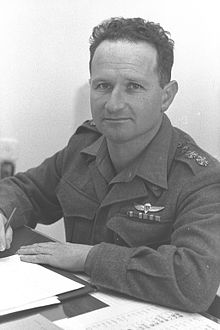Uzi Narkiss
Uzi Narkiss | |
|---|---|
 Narkiss in 1959 | |
| Native name | עוזי נרקיס |
| Born | January 6, 1925 Jerusalem, Mandatory Palestine |
| Died | December 17, 1997 (Aged 72) Jerusalem, Israel |
| Buried | Jerusalem, Israel (Mount Herzl) |
| Allegiance | Palmach, |
| Awards | Legion of Honour |
Uzi Narkiss (
Early life
Uzi Narkiss was born in Jerusalem to
Military career
In April 1948, Narkiss headed the assault on
Narkiss spent several years studying in France at the
During the Six-Day War on June 5, 1967, with seven brigades under his command known as Central Command, Narkiss was responsible for combating any possible Jordanian offensive. Capturing the Old City was not part of the plan. Israel Defense Forces (IDF) units moved effectively to take key positions in east Jerusalem, where one key location was Ammunition Hill. Still, to Narkiss' dismay, the politicians would still not allow the Old City to be taken. But with a looming cease fire approaching after an emergency meeting of the UN, Moshe Dayan gave the order to Narkiss who quickly capitalised on the opportunity to capture the city before any cease fire prevented this as an option. Under his direction, the Old City was captured on June 7 and Jerusalem was reunified under Israeli control. From Narkiss' viewpoint, this completed the campaign he had begun 19 years earlier, and whose previous failure had haunted him.
After the war, the Palestinian village of Beit Awwa was completely destroyed.[4] Moshe Dayan claimed the destruction was carried out under the orders of an officer who wished to expel the residents; Brigadier General Uzi Narkiss claimed the credit for the action.[5]
Later activities

In response to ongoing
In 1948, Uzi Narkiss searched the body of the dead Palestinian commander
Death
Narkiss died in 1997 after a long illness at the age of 72. He was buried in the military cemetery on Mount Herzl.[8]
References
- ^ "Poster of Uzi Narkiss". Archived from the original on 2006-05-12. Retrieved 2006-04-20.
- Jerusalem Post supplement by Greer Fay Cashman (partial interview with Narkiss) Archived April 10, 2005, at the Wayback Machine
- JSTOR 23401299.
- Jiflik, Agarith and Huseirat, in the Jordan Valley. The Special Committee has ascertained that all these villages have been completely destroyed. Para 58. the village of Nebi Samwil was in fact destroyed by Israeli armed forces on March 22, 1971.
- ^ Segev, 2007, p. 409
- ^ Oren, Amir (23 April 2011). "צה"ל חושף לראשונה את הכישלון בכראמה" [IDF Reveals Failure in Karameh For the First Time]. Haaretz. Retrieved 2 January 2023.
- ^ Husseini's Koran
- ^ "Israeli Gen. Narkiss Dies". Associated Press News. 18 December 1997. Retrieved 2 January 2023.
External links
- General Uzi Narkiss Archived 2017-10-10 at the Wayback Machine – A historic radio interview with General Uzi Narkiss on June 7 – one day after the Six-Day War, describing the battle for Jerusalem
- Central Zionist Archives in Jerusalem site. Office of Uzi Narkiss (S91)
